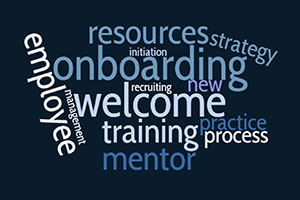 Recruiting has never been easy, regardless of what your clients think. You are typically asking someone to leave their employer to move to a new and unknown situation, and we know people do not like change. This is a huge unknown for most candidates you place. They research, they hope and in the end they take a risk and accept the position. Lots of fear, lots of change headed their way. An effective onboarding process can ease the transition. In these times, onboarding has become more difficult, but significantly more critical to making a new hire work for the long-term.
Recruiting has never been easy, regardless of what your clients think. You are typically asking someone to leave their employer to move to a new and unknown situation, and we know people do not like change. This is a huge unknown for most candidates you place. They research, they hope and in the end they take a risk and accept the position. Lots of fear, lots of change headed their way. An effective onboarding process can ease the transition. In these times, onboarding has become more difficult, but significantly more critical to making a new hire work for the long-term.
If you have made the placement, now the candidate transition through the guarantee period is critical to your success and income. A fall-off typically happens quickly based on pressures or surprises the employer or the candidate experience. Effective onboarding can help minimize the risk of dissatisfaction and a resulting fall-off. Turnover can be costly for the employer, the employee and for the recruiter making the placement. Some calculate the cost of this late stage fall-off as being upwards of three times the salary for the employer as the position has been vacant, is filled and then the process starts all over again. This leaves teams in disarray, important work untouched for months and ultimately clients and business goals unfulfilled.
Recruiters need to be hyper-vigilant on the employer’s onboarding process. They need to make sure the transition goes smoothly. When the onboarding could be done face-to-face there were challenges, but now the process is more difficult—yet even more important. Ask to support the process to ensure your placement will make the transition to the new employer successfully.
Engage in the Process
While the onboarding process is difficult for you to control, you need to engage and support the process used by the client. You might want to spend extra time with your candidate pre-employment working on defining the new employer’s culture and what makes candidates most successful. You might also ask to review the client’s onboarding procedures to see if you can highlight areas of most importance or areas that might be missing content.
If you have a placement history with the client, consider doing virtual sessions with the new hire and a past placement to coach your candidate on what they can expect. This level of engagement will set you apart from competitors and help protect the success of your placement work for this client and candidate match.
Good Onboarding Drives Success
The inability to meet face-to-face is a complicating factor. Use technology to overcome the lack of physical connection. You must get the new employee visually connected to co-workers and the team. Video conference is imperative. While the phone is nice, a visual is a critical need for people to truly connect to other people. Push your candidate to connect frequently and virtually with video at every step of the process. As new hires work from home, ask your employer or hiring manager to connect multiple times per week early on in the assignment. It is tough to start a new job where there is easy access and connection to your team and co-workers and complicated by everyone working remotely. Ask for a buddy/coach/peer connection that is formally assigned. Recruiters, if it could be one of your previous placements that is even better for you. Check in on both candidate and coach weekly to uncover issues before they fester and become unsolvable. Onboarding needs to shift from a purely paper-based process to a more social assignment. Recruiters can be the facilitators of this shift with careful consideration and client coaching.
Retention is Key
Onboarding, done well, can have implications for employee retention. According to research completed by Glassdoor, a powerful onboarding process can increase retention by as much as 82 percent. Obviously this data is from a pre-COVID-19 time and common sense would say that onboarding has perhaps even increased in importance with work-from-home (WFH), remote work driven by the virus.
Recruiters, the placement does not stop at the first day of work. Check-in with the employer and the candidate with frequency. Check to make sure both sides are doing effective communication and adaptation to the new company culture and a new employee. Do not overlook your impact on the onboarding process. Help your candidate make the adjustments needed until WFH is just an option and no longer a requirement.